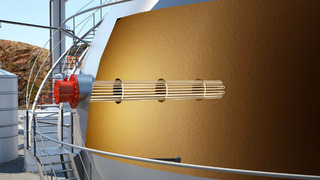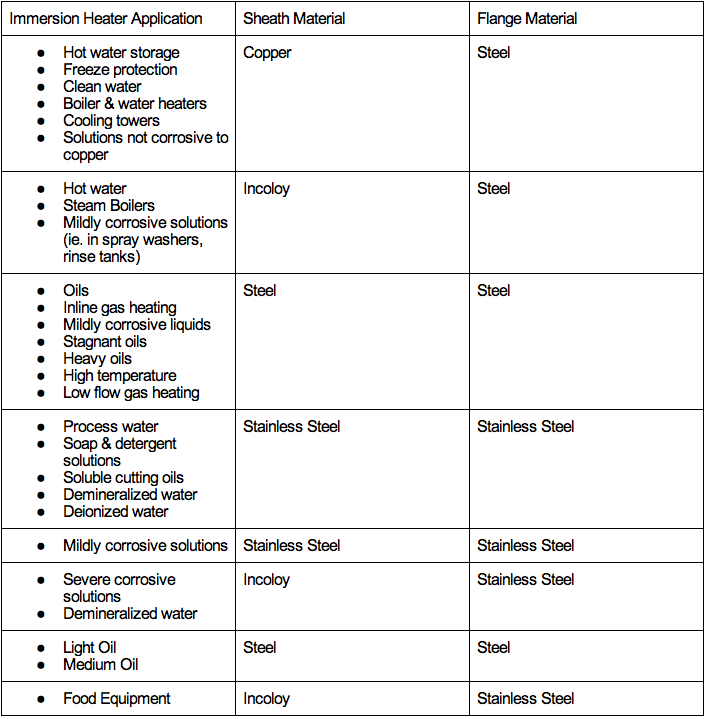Unique Considerations When Choosing An Immersion Heater
Last updated on February 10th, 2023 at 06:12 pm
It is important to choose the right immersion heater for your specific application to get the most efficiency and longest lifespan. Selecting the right industrial heating equipment reduces cost, improves efficiency & safety, and increases longevity. This article will outline how to select an immersion heater that best meets your needs.
Immersion heaters are designed for specific fluids. As such, it is important to consider the industry, purpose, and fluid the heater is intended to be used for. These break down into five main points to consider when choosing an immersion heater.
What factors should you consider when choosing immersion heaters?
When choosing an immersion heater, you must consider the:
- Materials Used For The Sheath & Flange
- Temperature
- Power Density
- Required Safety Specs
- Project Budget
Materials for immersion heater sheath & flange
The application and type of medium being heated determine the most appropriate materials to use. Some fluids, for example, are corrosive to specific materials, which must be considered when selecting materials.
Below we have listed some examples of immersion heater materials and their correlation to the type of processes they may be used for:
The application an immersion heater is used for is very important in selecting the right materials for the sheath & flange. Application is the most important factor in picking the right immersion heater for your process. However, there are additional factors to consider. Different materials can be selected to prevent or reduce corrosion from the heated medium or accommodate temperature needs.
Temperature
Temperature is an important part of the application. Desired temperature, temperature controls, and how fast the medium needs to reach its desired temperature all factor into the recommended type of immersion heater for a given process.
Desired Temperature
Flange heaters are capable of reaching high temperatures. This ability is in direct relation to the shift temperature of the tubular elements. As such, the desired temperature can influence the tubular elements used in the immersion heater.
For example, an immersion heater that used Incoloy can reach higher temperatures than its steel counterpart. When an immersion heater is used in a liquid, the temperature does not, typically, exceed 500°F. However, in air, the temperature can exceed 1000°F. In this case, temperature controls are essential.
Temperature Controls
Industrial heating typically requires, and always benefits from, highly specific temperature maintenance that can be achieved through temperature control panels. For processes that require, or have the potential for, extreme heat temperature controls may be a necessity. Where they are needed, we provide a selection of industrial control panels that can be highly customized to meet the needs of your process.
Control panels maintain stability and heat transfer efficiency. They regulate temperature and provide safety mechanisms that prevent overheating and chemical disintegration. The control panels are housed in terminal boxes that can be made dust-proof, waterproof, and explosion-proof.
In addition to protecting the equipment and medium being heated, as well as safety assurances, temperature controls can increase efficiency through automation. Wattco control panels also come with circuit schematics and support documentation for configuration.
How Fast The Fluid/Medium Needs To Reach Its Desired Temperature
In addition to the importance of the desired temperature, how fast the fluid/medium needs to reach this temperature should be taken into consideration as well.
Flanged heaters have specially designed baffles that allow the flow of liquid to pass through the heating elements easily. This is an extremely important process as the flow of liquid allows heat transfer to occur more efficiently.
Using a solid baffle prevents the flow of liquid. This can cause the liquid to carbonize and cause unnecessary stress to the pumps. Taking time and temperature into consideration helps ensure immersion heaters’ longevity and efficiency.
Power Density
Voltage and amperage are very important factors to consider when designing an electric heating element. For example, a higher voltage reduces the amperage rating and accommodates the immersion heater with the appropriate controls.
What Voltage Is Available
Electric immersion heaters require specific voltages. Wattco immersion heaters can be calibrated for different voltage types. We can make more informed recommendations based on your voltage and wattage requirements.
Larger flanged heaters, for example, used for large volumes of liquid or big tanks, require higher voltages as the wattage required is higher. This increased voltage reduces the amperage.
What Amperage Is Available
As with voltage, the available amperage must be considered in the configuration of immersion heaters. Amperage and voltage are tied together, the higher the voltage, the lower the amperage available.
Required Safety Specs
Being aware of required safety specifications is a necessity in the selection of immersion heaters, control panels, and terminal housing boxes. The application and location typically factor into the safety specifications required.
Standard or Explosion Proof Environment?
For standard processes, a NEMA 1 box may be adequate. They are general-purpose enclosures that primarily prevent human contact with the circuitry.
An explosion-proof environment is necessary for natural gas or other potentially explosive applications. These enclosures are Engineered to reduce the chance of sparks and flames to keep it safe for users. NEMA 7 boxes are designed to contain explosions.
Indoor or Outdoor Environment?
NEMA 1 enclosures should be used indoors, in most cases, they may not be ideal for outdoor or wet environments.
To protect against severe condensation drip, tight NEMA 2 boxes may be more appropriate. However, for outdoor applications, weather-resistant NEMA 4 boxes are often more appropriate. They protect against dirt, dust, and weather. It is commonly used in construction sites.
If submersion is likely to occur, NEMA 6 boxes are completely submersible in water and oils. Standard 6 boxes can be submerged for short periods, while 6p can be submerged longer. Neither, however, are designed for permanent submersion.
Full information on NEMA control panel enclosures can be found in our in-depth control panel article.
Budget
The budget available for your product may determine what immersion heaters are available to you. If you know the exact specifications for the machinery required, you can submit a quote for a flanged heater or another specific device. You can also email or call us directly to receive a recommendation for an immersion heater that fits your application and budget.
Find The Right Immersion Heater For Your Process
There are a lot of considerations to take into account when choosing an immersion heater. The most important factor is the application the heater will be used for. However, materials, temperature, power density, safety specifications, and budget must also be considered. Submit a contact form for immersion heater recommendations, and we will help you find a heater that fits your needs and budget.


